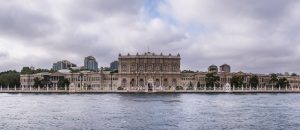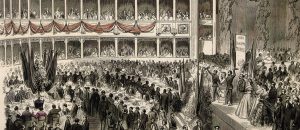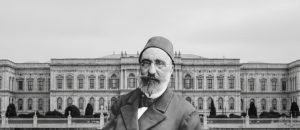Dolmabahçe Palace’s interior architecture is a conscious display of power, designed to make every detail psychologically impact the visitor, especially foreign ambassadors, making them feel the overwhelming power of the empire. The high ceilings, enormous voids, majestic columns, and striking lighting are not merely aesthetic preferences but political tools that convey the wealth, order, and authority of the Ottoman State without the need for words. This architectural language is structured to impress, astound, and ultimately ensure that everyone who steps inside respects the greatness of the state. [Link: Dolmabahçe’nin genel mimari stratejisi -> /explore/grand-design-architecture]
The Muayede Hall: Overwhelming Grandeur at the Heart of the Empire
The place where the display of power in Dolmabahçe’s interior architecture reaches its peak is undoubtedly the Muayede Hall (Ceremonial Hall). This massive space intentionally exceeds the human scale with its 56 columns, 36-meter dome height, and approximately 2,000 square meters of area. The first feeling a visitor experiences upon entering the Hall is their own smallness compared to the size of the structure and the empire it represents. This is not a coincidental feeling; it is a psychological effect calculated by the Balyan architects to evoke “awe and admiration” in the ambassadors who would appear before the Sultan.
The element that crowns this effect is the colossal 4.5-ton crystal chandelier, a gift from Queen Victoria, hanging from the dome. This object, one of the largest chandeliers of its era, is not just a lighting fixture but also a symbol of Ottoman technological and financial power. This artificial sun at the center of the Sultan’s universe is a luminous message demonstrating how brilliant the empire’s wealth and international relations were.
The Language of Scale and Void: The Art of Diminishing the Visitor
The understanding of overwhelming scale in the Muayede Hall is extended to other spaces in the Selamlık section of the palace. The ceiling height, wide corridors, and large windows in important reception areas like the Süfera Salonu (Ambassadors’ Hall) and the Red Room constantly create a feeling of spaciousness and monumentality. This never overwhelms the visitor but constantly reminds them how much larger the structure and the state they are in are than themselves. This marks a radical break from the lower-ceilinged, more human-scaled, and intimate rooms of Topkapı Palace.
These vast voids and high ceilings are also designed to enhance the splendor of the ceremonies. An embassy delegation or the Sultan’s retinue proceeding down a wide corridor presents a much more impressive spectacle within these monumental spaces. Architecture here functions as a stage set that glorifies state rituals. [Link: Sarayda değişen törenler hakkında daha fazla bilgi -> /sini-yerine-balo-salonu-dolmabahcenin-mimarisinin-yuzyillik-saray-torenlerini-nasil-degistirdigi]
The Diplomacy of Light: Dazzling with Gold Leaf and Crystal
In Dolmabahçe’s interiors, light is skillfully used to display power and wealth. The enormous windows overlooking the Bosphorus let in plenty of natural light, illuminating the spaces and emphasizing the palace’s outward-looking character. However, the real display of power is created by the reflection of this natural light within the interior. Kilograms of gold leaf covering the ceilings, hundreds of chandeliers, candelabras, and wall sconces made of Baccarat and Bohemia crystal, reflect and divide the light into thousands of pieces, creating a dazzling sparkle.
This sparkle is not only a sign of luxury but also a symbol of an “enlightened” monarchy. It is visual propaganda describing how brilliant and prosperous the empire was under the Sultan’s administration. Especially at night, illuminated by hundreds of candles and gas lamps, these spaces prove to European visitors that the Ottoman Palace could easily compete with the most glittering palaces in their own capitals. Studies on architectural psychology show that bright and shining spaces are associated with power and positive authority. [Link: Architectural Psychology Insights -> https://www.archdaily.com/906372/the-impact-of-architecture-on-human-emotion]
** Conclusion**
In conclusion, the ceilings, columns, and voids of Dolmabahçe Palace, beyond aesthetic concerns, constitute a complex architectural language designed to display the power of the empire. The overwhelming scale of the Muayede Hall, the monumentality in the general spaces, the diplomatic use of light, and the generous display of precious materials combine to paint the image of the Ottoman State as modern, wealthy, and self-confident. Visiting Dolmabahçe’s interiors is, therefore, not just wandering through beautiful rooms, but also witnessing one of the most spectacular displays of power of an empire.



















